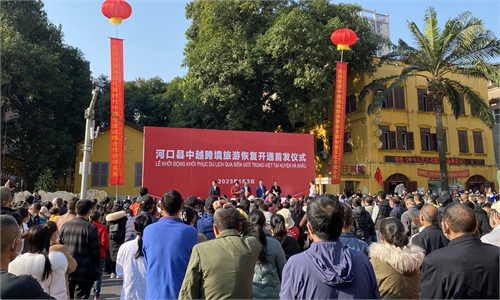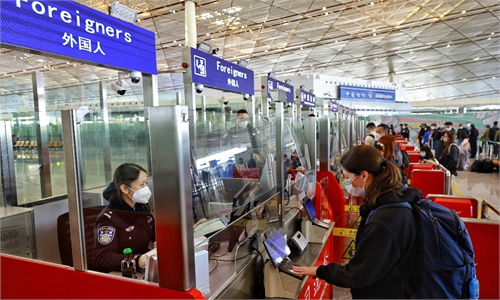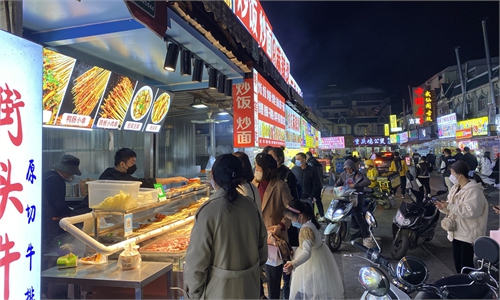GT on the spot: Wanding port, Yunnan, rapidly recovering in regained bustle
Trucks, passengers line up to cross China-Myanmar border
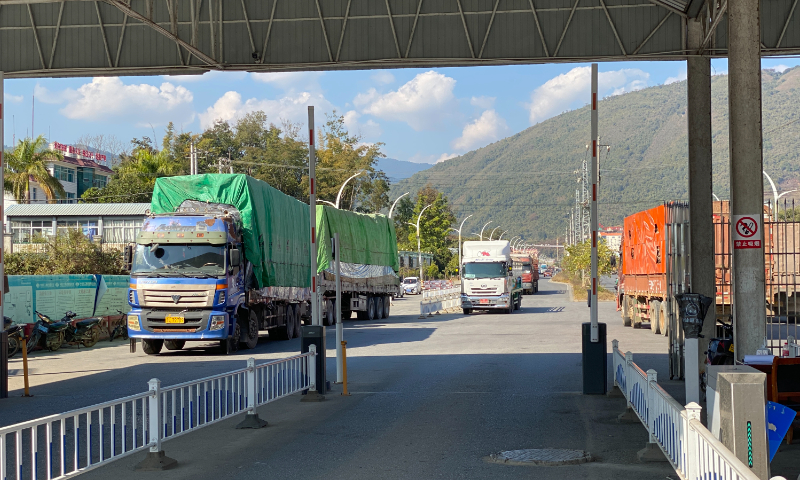
Lorries wait to move through the Mangman passage of the Wanding Port in Ruili, Southwest China's Yunnan Province on January 11, 2023. Photo: Li Qiaoyi/GT
On Wednesday afternoon, two lines of fully loaded trucks were waiting to be cleared at the Mangman passage of the Wanding Port in Southwest China's Yunnan Province.
One line of trucks carrying Myanmar fruit was heading toward the Chinese side, while the other line loaded with Chinese small commodities and home appliances was en route to Myanmar.
The bustling scene epitomizes the resilience of the port, which was suspended for nearly 100 days in 2021 due to the coronavirus pandemic.
Around 200 trucks moved through the passage per day during the past three years. The reading shot up to roughly 500 since the start of 2023, a staffer with the Wanding Port management office told the Global Times on Wednesday.
Cargo traffic handled at the passage has hit about 7,000 tons a day, according to the staffer.
Watermelons, sugar cane and other Myanmar-origin fruit recently topped the list of imports from the Southeast Asian nation. The passage has given the green light to prioritize the clearance of trucks carrying tropical fruits.
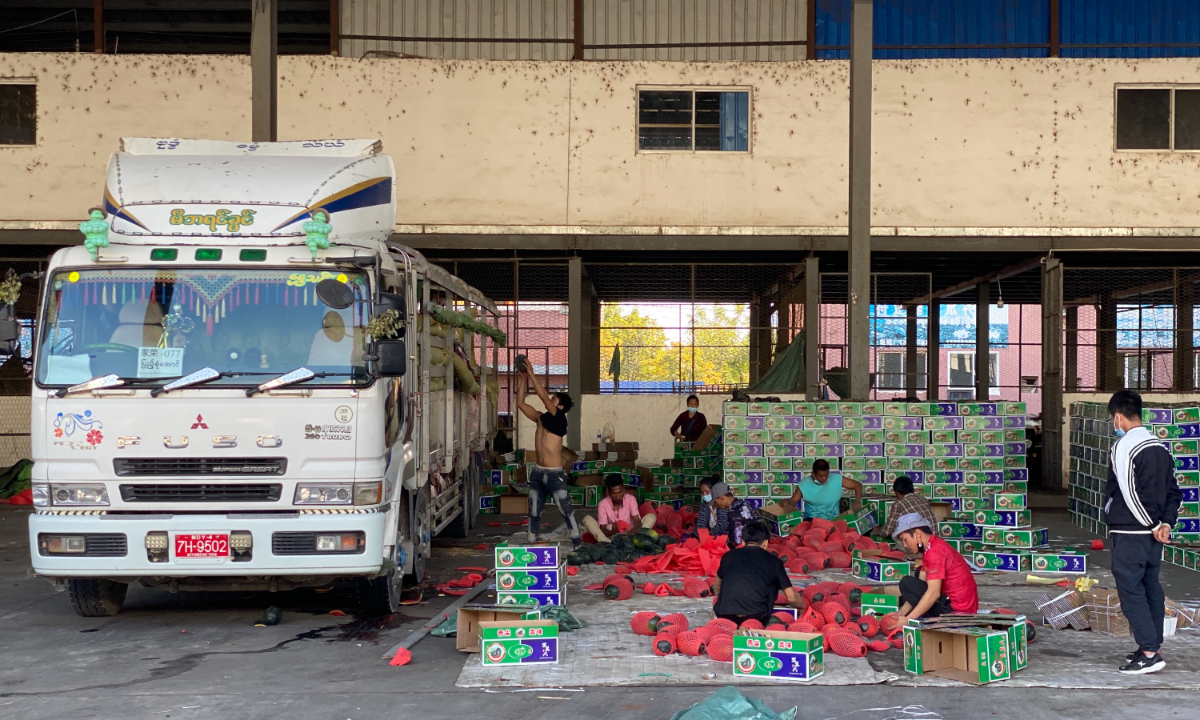
Workers unload and pack watermelons at a distribution center near the Mangman passage of the Wanding Port in Ruili, Southwest China's Yunnan Province on January 11, 2023. Photo: Li Qiaoyi/GT
Special channels have been added to expedite shipments of fresh food and farm produce, the Global Times learned.
In a step toward closer trade ties between China and Myanmar, the Wanding Port was elevated to fall under the jurisdiction of the commerce bureau of the Dehong Dai and Jingpo Autonomous Prefecture, effective January 1. Previously, it was administered by the city of Ruili.
The elevation suggests the Wanding Port will get priority when it comes to funding, infrastructure improvement and a smart port push.
The Mangman passage of the Wanding Port is envisioned to be built into a major cargo thoroughfare in Yunnan. As part of the vision, the port aims to be authorized as a designated port for traditional Chinese medicine imports, the staffer disclosed.
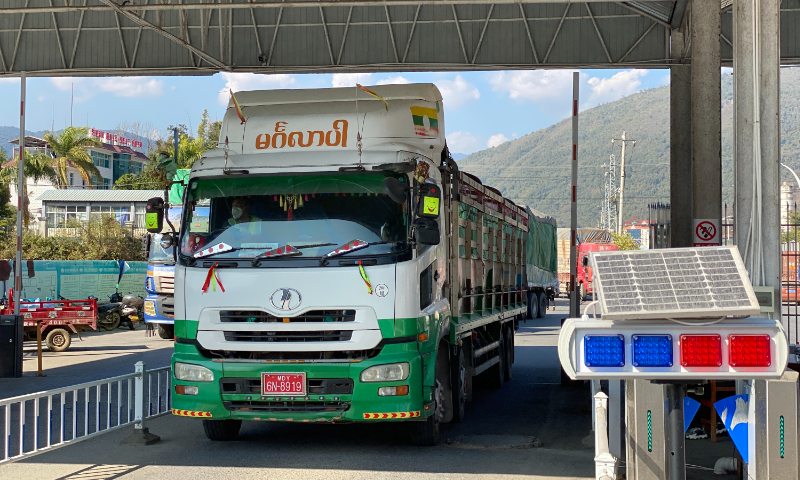
Lorries wait to move through the Mangman passage of the Wanding Port in Ruili, Southwest China's Yunnan Province on January 11, 2023. Photo: Li Qiaoyi/GT
The port is currently designated as a conduit for imports of grain and fruit. It's also the only port in Yunnan for imports of unprepared, chilled products and the province's first authorized land port to handle inbound edible seafood and designated port for plant-based feed.Such a vision is considered to instill optimism into the border city of Ruili.
With its Wanding Port, which borders Myanmar, resuming operation in November 2021, Ruili recorded 59.19 billion yuan ($8.74 billion) worth of foreign trade in 2022, official data showed.
As China optimized its COVID-19 response, the port's Mangman passage returned to its pre-pandemic clearance mode on December 19, 2022, opening more import channels for fresh products, extending customs clearance time and improved efficiency.
In 2022, Wanding Port was listed as a provincial-level smart port construction pilot project, with 17 planned sub-projects worth 2.73 billion yuan. One core sub-project involving information construction in 2023 is expected to kick off on February 3.
The overall structure of Ruili's smart ports includes four aspects - intelligent interaction, intelligent connection, an intelligent center and intelligent application.
Taking the Wanding Port's Mangman passage for instance, it aims to realize a digital transformation and to set a world-class port benchmark.
The border city's economy offers more rays of hope.
Li Zhaoxia, an executive at an electronics component manufacturer in the import and export processing and manufacturing base of Ruili's industrial park, told the Global Times that after moving production lines to Ruili, Li promised her upstream clients that the company could enjoy lower labor costs and enhanced competitiveness, and she hoped the company could receive more orders.
"Soon after China optimized its COVID response and reopened the border, we rented a building next to our factory, and it is expected that the number of employees would increase to 800 this year from the current 300," Li said.
Wang Baoxiang, a Myanmar staffer who works in Ruili, told the Global Times that he is very satisfied with all aspects of working in Ruili, and now he earns at least 3,000 yuan per month more than his peers at home.
After posting a job, Li noted that Myanmar employees at her factory spread the word to friends and family back home, and nearly 600 people signed up overnight.
"The salary here, the factory environment, the humane management, I should say all aspects here are attractive to our Myanmar friends," she said.
There were 24 enterprises in the import and export processing and manufacturing base of Ruili's industrial park in 2022, with eight enterprises recording over 20 million yuan in annual revenues from principal businesses. The manufacturing base was estimated to achieve gross industrial output of 290 million yuan and fixed-asset investment of 130 million yuan in 2022.
Investing here is far better than moving factories abroad, Li said, and more firms will pay attention to border cities like Ruili as they could enjoy low labor costs while working near home.
Ruili currently has 29 enterprises whose principal businesses generate annual revenues of at least 20 million yuan, mainly involving 16 sectors such as electricity, automobiles, biological medicine, chemical fertilizer and solar panels.
It achieved an estimated industrial added value of 528 million yuan in 2022, up 2.6 percent year-on-year, per official data.
